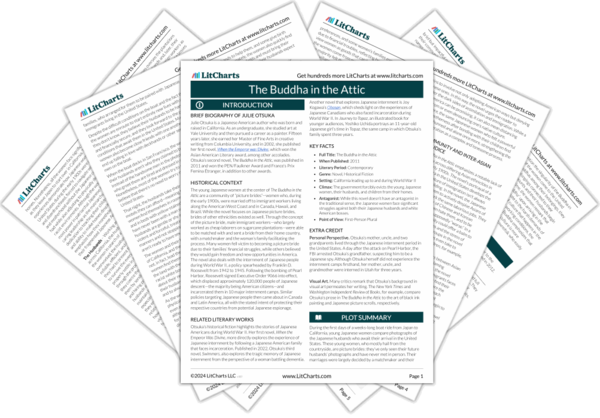Welcome to the LitCharts study guide on Julie Otsuka's The Buddha in the Attic. Created by the original team behind SparkNotes, LitCharts are the world's best literature guides.
The Buddha in the Attic: Introduction
The Buddha in the Attic: Plot Summary
The Buddha in the Attic: Detailed Summary & Analysis
The Buddha in the Attic: Themes
The Buddha in the Attic: Quotes
The Buddha in the Attic: Characters
The Buddha in the Attic: Terms
The Buddha in the Attic: Symbols
The Buddha in the Attic: Theme Wheel
Brief Biography of Julie Otsuka

Historical Context of The Buddha in the Attic
Other Books Related to The Buddha in the Attic
- Full Title: The Buddha in the Attic
- When Published: 2011
- Literary Period: Contemporary
- Genre: Novel, Historical Fiction
- Setting: California leading up to and during World War II
- Climax: The government forcibly evicts the young Japanese women, their husbands, and children from their homes.
- Antagonist: While this novel doesn’t have an antagonist in the traditional sense, the Japanese women face significant struggles against both their Japanese husbands and white American bosses.
- Point of View: First-Person Plural
Extra Credit for The Buddha in the Attic
Personal Perspective. Otsuka’s mother, uncle, and two grandparents lived through the Japanese internment period in the United States. A day after the attack on Pearl Harbor, the FBI arrested Otsuka’s grandfather, suspecting him to be a Japanese spy. Although Otsuka herself did not experience the internment camps firsthand, her mother, uncle, and grandmother were interned in Utah for three years.
Visual Art. Many critics remark that Otsuka’s background in visual art permeates her writing. The New York Times and Washington Independent Review of Books, for example, compare Otsuka’s prose in The Buddha in the Attic to the art of black ink painting and Japanese picture scrolls, respectively.







